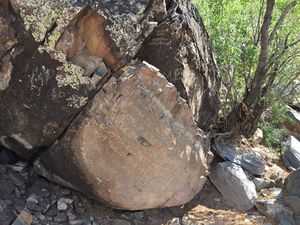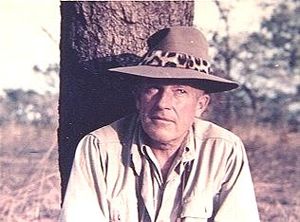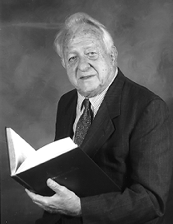Los Lunas Decalogue Stone
Jump to navigation
Jump to search
By Mia Pardel
What is the Los Lunas Decalogue Stone?


- The Los Lunas Decalogue Stone is a basalt slab on the side of Hidden Mountain near Los Lunas, New Mexico, United States. The stone slab is supposedly inscribed with the Ten Commandments, or Decalogue, from the Judaism or Samaritan religion written in ancient Hebrew-Phonecian script. [1]
- This inscription has been studied quite a bit and the Hebrew-Phonecian script is believed to have Greek influence due to the substitution of Greek letters in place of traditional Hebrew ones, as well as influence from other scripts from Europe and the Middle East. [2]
- This combination of Hebrew, Phonecian, Greek, Moabite, and Roman scripts has not been seen in use anywhere else. It is very specific and unique to the Los Lunas Decalogue Stone. [3]
- The basalt that the inscription is on was once at the top of Hidden Mountain and has since fallen down the mountainside. The angle of the inscription on the stone slab in its current position, also supports this idea that the stone was once at the peak of the mountain. The stone is positioned around 40 degrees clockwise from horizontal about 2/3 down the side of Hidden Mountain. [4]
- Many believe that the stone is anywhere from 500 to 2,000 years old however, George Moorehouse, a professional geologist, has compared the surviving weathering on the inscription to that on a nearby modern graffiti dating itself to 1930. [5]
Discovery
- The Los Lunas Decalogue Stone was first written about by Professor Frank Hibben, an archaeologist and professor from the University of New Mexico, in 1933. While Hibben was the first to write about it, it was discovered by a local guide who had seen it back in the 1880s. When Hibben came to Los Lunas and the surrounding area, the anonymous guide lead him back to the Los Lunas Decalogue Stone and other inscriptions around the site. [6]
- After this discovery was published, many scholars set about doing their own translations and transcriptions of the ancient text. Many other scholars talked with Hibben or conducted their own research to see if they drew similar conclusions to Hibben’s. [7]
Frank Hibben Ph.D.

- Frank Hibben was interested in archaeology from a young age and pursued this career at Princeton University where he received his bachelor’s in archaeology. He later received a Masters in zoology and a Ph.D. in anthropology. [8]
- Hibben has had quite a history with pseudoarchaeological claims and ideas. He made a discovery in the Sandia Mountains of pre-Clovis artifacts which he believed to be much older than ancient Native American cultures. While his estimation of 25,000 years old was based on the strata in the cave in the Sandia Mountains, it was later proven that a burrowing animal made the deposit so deep in the strata. [9] [10] [11]
- Many professional archaeologists believed Hibben had actually buried these artifacts in the cave and later rediscovered them. However, it was never proven that Hibben was part of this fraud. [12]
- He had a few other questionable experiences in his fieldwork; including the hyperdiffusionistic ideas of projectile points throughout North America and animal bone identification in relation to a site and its age. [13]
- Hibben has also written many books on different subjects in archaeology as well as on hunting big game. This combined with his position as a museum director allowed him to become extremely rich. He donated a lot of his money before and after he died to the University of New Mexico in building construction, in research funding, and in scholarships. [14]
Cyrus Gordon Ph.D.

- Cyrus Gordon studied ancient languages and ancient Near East cultures and was a hyperdiffusionist and pseudoarchaeologist. He held many similar beliefs that ancient Jews and Samaritans crossed the Atlantic Ocean and created the first societies and cultures in the Americas. [15]
- He proposed the decalogue stone was a Samaritan mezuzah. The Jewish mezuzah is a little scroll that is held in a container and placed by the entrance to a house. Ancient Samaritan mezuzahs, however, were large stone slabs placed by a gateway to a home or synagogue. These often had a version of the Ten Commandments or Decalogue written on them. [16]
- It is not uncommon for Samaritan religious texts and inscriptions to have Greek words in them, this is common both in ancient Samaritan writing and in contemporary writings and rituals. [17]
- Gordon used the Los Lunas Decalogue Stone, the Bat Creek Inscription, and several other fraudulent artifacts to create the idea that Samaritan shipowners that lived in Greek communities at the time of Theodosius I circa 390 A.D.were most likely responsible for the Los Lunas inscription and that their age is the Byzantine period. [18]
- Gordon’s idea has been disproven since Prof. Reinhard Pummer, an expert on Samaritan religion and practices both ancient and contemporary, wrote that he does not believe that the Los Lunas inscription could be Samaritan. He explains that, in Verse 8, the Los Lunas text follows the standard Jewish text by saying "remember the Sabbath day to keep it holy," whereas the Samaritan text says "preserve the Sabbath day to keep it holy." He adds that Samaritans generally added another part to the tenth commandment for a temple to be constructed at Mt. Gerizim, but it is not in Los Lunas Decalogue Stone. He concludes that while there is a script with the Greek language in Samaritan letters, he is not aware of Greek-style letters ever appearing in Samaritan inscriptions as is seen in the Los Lunas Decalogue Stone inscription. [19]
Condition of the Stone
- The Los Lunas Decalogue Stone is still on the side of Hidden Mountain. When it was discovered in 1933, the stone was covered with lichen and patination making the inscriptions barely visible.
- However, the inscriptions are clear and legible, not something one would expect from an ancient artifact out in the elements for hundreds of years. [20]
- There is a lot of graffiti near the Los Lunas Decalogue Stone; both around the stone and on the same basalt stone at the top of Hidden Mountain. [21]
- Today it still sits on the side of Hidden Mountain on state trust land. The State of New Mexico has the stone listed on their website as the “Mystery Stone” and they sell family passes to drive out and see the Los Lunas Decalogue Stone and other graffiti and inscriptions nearby. [22]
- As of 2008, the inscription itself is badly chalked and scrubbed up due to people travelling out to the Los Lunas Decalogue Stone and cleaning it due to religious belief.
Context
- There is little to no cultural context for the Los Lunas Decalogue Stone. Beyond contemporary uses for tourism and pseudoarchaeological papers and research, there is little significance to this stone. When the stone was first discovered, it was argued that it had to be ancient due to the Phonecian-Hebrew script which was not known when the original discoverer happened upon it. This, of course, means nothing in that in the 1930s people in the Southwest knew of Phonecian-Hebrew scripts and that the original discoverer could have lied about seeing it then. [23] [24]
Pseudoarchaeological Narrative
Hyperdiffusionism and Biblical Literalism
- This specific narrative focuses on the hyperdiffusion of culture and civilization from Europe and the Middle East to the Americas. It uses biblical literalism only as a secondary cover from pseudoarchaeology.
The Narrative
- The narrative for this pseudoarchaeological find is that since there is evidence of people with the knowledge of ancient Hebrew-Phonecian script in the American Southwest, it is implied that ancients Jews travelled to New Mexico to write out their Ten Commandments. [25] Since there is supposed evidence of ancient Jews coming to the Americas and that Hibben specialized in pseudoarchaeological claims about the origins of people in the Americas it is then pulled to assume that people in the Americas are descendants of the ancient Jews that wrote that inscription. [26]
- This narrative however does not hold up to the archaeological community’s investigation. When the idea that ancient Jews travelled to the Americas, specifically Albuquerque, New Mexico, is considered, archaeological context is needed. This case does not have any context. Since Albuquerque is land-locked, there would need to be evidence of them travelling by land. This would include encampments, eaten food, disposed trash, broken things, performed rituals and many other things. However, the archaeological record holds no evidence of this happening anywhere in the American Southwest, in North America, or all of the Western Hemisphere. [27]
Hyperdiffusionism
- Hyperdiffusion is the notion that all major cultural innovations and societies derived from one ancient state to others. This notion generally refers to an ancient, lost civilization that was much more technologically advanced than other ancient cultures, but not always. In this case, Hibben used European or Middle Eastern cultures diffusing to North America.[28]
- Hibben’s idea that people from Europe or the Middle East came to North America and created the Los Lunas Decalogue Stone and other inscriptions around the Southwest is hyperdiffusion. Many other people find that this supports the idea that the first people in the Americas were from Europe or the Middle East, when they were not. There is ample archaeological evidence for this but yet, some pseudoarchaeologists hold onto this and a few other fraudulent artifacts as true. [29]
- This idea says that this “sign of culture” can only be from European or Middle Eastern cultures is ethnocentric and racist towards Native Americans. This idea also diminishes their culture and the advancements that they had. * These hyperdiffusionistic ideas are incredibly harmful to Native Americans and their cultures as seen in today’s society and to archaeology in general with false ideas about our past.
Biblical Literalism
- Biblical literalism is when someone takes an event or idea in the Bible literally, either an event quite literally happened exactly as the Bible describes, or as the ideas are not exactly true but they all did happen. There are many examples of this in pseudoarchaeology today, including the Cardiff Giant, Noah’s ark ideas, Joseph’s grain silos idea, the age of the earth in Genesis, and many, many more.
- This plays into this narrative of the Los Lunas Decalogue Stone in that many people claim that the stone was made by a lost tribe of Israel or some other biblical figure that left their known world. [30]
- This idea is dangerous in that it ignores other archaeological evidence of Native Americans in North America and it uses false evidence from other pseudoarchaeological sites to claim that the first people in the Americas were from the Bible’s narrative and that many actual historical events are false.
- This is harmful in several ways. First, it spreads the false narrative that Native Americans were not the first people in the Americas. Secondly, it harms Native Americans in today’s society with its racist and ethnocentric notions that Native Americans were not capable of culture. And lastly, it harms archaeology and history with its false ideas and inaccurate narrative of the past and the peoples of the past.
Popular Media
- The Los Lunas Decalogue Stone is not really present in popular media today beyond being used to support ethnocentric and racist ideals in books and scholarly discussions. It is widely disregarded by academia in that it has been proven to be a fraudulent artifact and does not provide to the ancient history and archaeology of the Americas or the American Southwest. [31]
Importance
It is incredibly important to recognize sites, artifacts, and ideas like this as pseudoarchaeological and false. These ideas of ethnocentrism and racism are very harmful to archaeology, society, and the people that these claims ignore. Talking through why something is pseudoarchaeological with these people is important because they might see how they are hurting others with their claims, this claim for example harms Native Americans by disregarding their culture and advancements. This claim hurts real people, it does not just sit on a shelf and not change things.
References
- ↑ https://www.asc.ohio-state.edu/mcculloch.2/arch/loslunas.html/
- ↑ https://history.unt.edu/sites/history.unt.edu/files/users/dlg0130/AscentsVolume2.pdf#page=99/
- ↑ https://books.google.com/books?id=xmDnhPNLwYwC&pg=PA159&dq=Los+Lunas+Decalogue+Stone+feder#v=onepage&q=Los%20Lunas%20Decalogue%20Stone%20feder&f=false/
- ↑ https://www.asc.ohio-state.edu/mcculloch.2/arch/loslunas.html/
- ↑ https://www.asc.ohio-state.edu/mcculloch.2/arch/loslunas.html/
- ↑ https://www.asc.ohio-state.edu/mcculloch.2/arch/loslunas.html/
- ↑ https://www.asc.ohio-state.edu/mcculloch.2/arch/loslunas.html/
- ↑ "Frank Hibben Funds New UNM Anthropology Building". University of New Mexico. Retrieved April 21, 2017./
- ↑ Bliss, Wesley L (1940a). "A Chronological Problem Presented by Sandia Cave, New Mexico". American Antiquity. Society for American Archaeology. 5 (3): 200–201. doi:10.2307/275278. JSTOR 275278./
- ↑ "Sandia Cave". Correspondence in American Antiquity. 6 (1): 77–78. 1940b./
- ↑ "The Mystery of Sandia Cave". The New Yorker. New York. 71 (16): 66–83./
- ↑ "The Mystery of Sandia Cave". The New Yorker. New York. 71 (16): 66–83./
- ↑ Thorson, R. M., D. C. Plaskett, and F. C. Dixon, Jr., 1978, A Reported Early-Man Site Adjacent to Southern Alaska's Continental Shelf: A Geologic Solution to an Archeologic Enigma. Quaternary Research. v. 13, no. 2, pp. 259-273. /
- ↑ Bliss, Wesley L (1940a). "A Chronological Problem Presented by Sandia Cave, New Mexico". American Antiquity. Society for American Archaeology. 5 (3): 200–201. doi:10.2307/275278. JSTOR 275278./
- ↑ Gordon, Cyrus, "Diffusion of Near East Culture in Antiquity and in Byzantine Times," Orient 30-31 (1995), 69-81./
- ↑ https://www.asc.ohio-state.edu/mcculloch.2/arch/loslunas.html/
- ↑ https://www.asc.ohio-state.edu/mcculloch.2/arch/loslunas.html/
- ↑ https://www.asc.ohio-state.edu/mcculloch.2/arch/loslunas.html/
- ↑ https://www.asc.ohio-state.edu/mcculloch.2/arch/loslunas.html/
- ↑ https://books.google.com/books?id=xmDnhPNLwYwC&pg=PA159&dq=Los+Lunas+Decalogue+Stone+feder#v=onepage&q=Los%20Lunas%20Decalogue%20Stone%20feder&f=false/
- ↑ Morehouse, George E.; "The Los Lunas Inscriptions, a Geological Study," Epigraphic Society, Occasional Publications, 13:44, 1985./
- ↑ https://archive.is/20130415104140/http://www.nmstatelands.org/recreational_access_4.aspx/
- ↑ https://books.google.com/books?id=xmDnhPNLwYwC&pg=PA159&dq=Los+Lunas+Decalogue+Stone+feder#v=onepage&q=Los%20Lunas%20Decalogue%20Stone%20feder&f=false/
- ↑ https://archive.is/20130415104140/http://www.nmstatelands.org/recreational_access_4.aspx/
- ↑ https://books.google.com/books?id=xmDnhPNLwYwC&pg=PA159&dq=Los+Lunas+Decalogue+Stone+feder#v=onepage&q=Los%20Lunas%20Decalogue%20Stone%20feder&f=false/
- ↑ https://history.unt.edu/sites/history.unt.edu/files/users/dlg0130/AscentsVolume2.pdf#page=99/
- ↑ https://books.google.com/books?id=xmDnhPNLwYwC&pg=PA159&dq=Los+Lunas+Decalogue+Stone+feder#v=onepage&q=Los%20Lunas%20Decalogue%20Stone%20feder&f=false/
- ↑ https://www.asc.ohio-state.edu/mcculloch.2/arch/loslunas.html/
- ↑ https://history.unt.edu/sites/history.unt.edu/files/users/dlg0130/AscentsVolume2.pdf#page=99/
- ↑ https://history.unt.edu/sites/history.unt.edu/files/users/dlg0130/AscentsVolume2.pdf#page=99/
- ↑ https://books.google.com/books?id=xmDnhPNLwYwC&pg=PA159&dq=Los+Lunas+Decalogue+Stone+feder#v=onepage&q=Los%20Lunas%20Decalogue%20Stone%20feder&f=false/